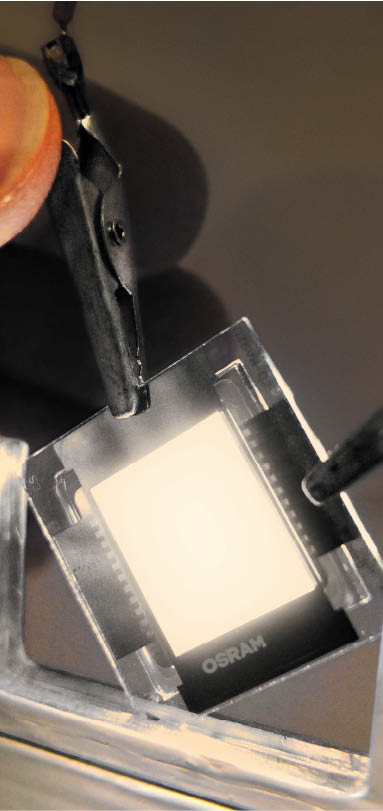OLED TV technology in residential lighting

As true technophiles would be aware, LCD and Plasma displays are on their way out – to be superseded by surface emission displays, laser TV and, more imminently, organic light emitting diode (OLED) screens, which first hit the market last year.
Such is the potential of OLED, however, it has caught the attention of major lighting manufacturers – OSRAM, Philips and GE.
ADVERTISEMENT
At present, these three companies, as well as a handful of smaller specialist manufacturers, are racing to be the first company to transfer the inherent benefits of OLED TV technology to a viable lighting system, first for commercial applications, then residential.
“OLED is a completely new technology,” says light bulb and electronic control gear manufacturer OSRAM. “It is a two-dimensional source that provides a soft light that is largely glare-free with no harsh shadows. It is possible to look directly at OLED light sources without being dazzled – in complete contrast to conventional light sources such as incandescent lamps, halogen lamps and LEDs.
“Further, OLEDs are extremely thin. Their active layers have an overall thickness of less than 500nm (nanometres), which is 100 times thinner than a human hair. The total thickness of the component is typically 1.5mm, comprising the glass substrate and the encapsulation. Even this can be reduced considerably by using thinner and more flexible substrates and thin-film encapsulation.”
OLEDs, with their special properties (two-dimensional light source, transparent, ultra low profile, potentially flexible), are opening up new applications such as light tiles, light partition walls, and transparent light sources that emit light only after dusk and act as windows during the day. OLEDs can also be integrated in kitchen and bathroom installations, for example, to create revolutionary lighting designs.
The greatest successes, however, are expected in applications in which the unique features of OLEDs are used to greatest effect, for example, in extremely thin, efficient and transparent two-dimensional light sources with excellent quality of light.
“The OLED lighting markets will develop as advances are made in the technology and as costs fall,” it says.
“For applications in general illumination, chip architectures are being developed that will emit white light at high intensity (up to 4,000cd/m², corresponding to an emission of around 12,000lm/m²).
“The special properties of organic light emitting diodes will be the unstoppable driving force behind the transition from the first phase of purely emotional lighting to the second phase of functional light sources for the premium design sector. This includes the possibility of producing transparent OLEDs and precisely defining the direction in which light is emitted and the amount of light emitted. At the same time, the efficiency and brightness of the light will be improve at a rapid rate, coupled with optimised production processes that will lead to higher production volumes.
“Entirely new lighting applications may be developed with effects that we can now only imagine. In the general illumination sector, one of these innovative applications could be transparent (roof) windows. By day the windows would allow natural light through, and by night they would provide light themselves, eliminating the unattractive sight of the windows becoming nothing more than dark patches.”
OSRAM considers the ultimate development goal for OLED light sources to be volume business in the general lighting sector. This third mass market phase will start as soon as OLEDs can be manufactured in very high quantities with consistently high quality, and appropriate demand has built up on the world market.
-
ADVERTISEMENT
-
ADVERTISEMENT

